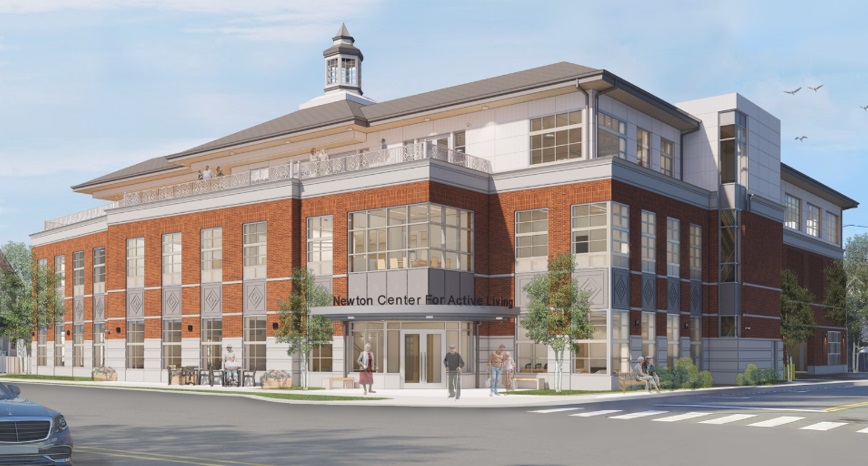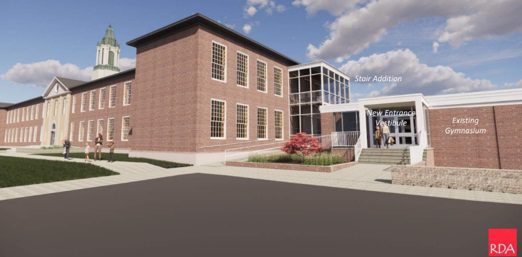Buildings1
Concept design for the new Countryside School. Courtesy Photo
Newton is in the midst of a construction renaissance, with the city’s government modernizing the city brick by brick, beam by beam and village by village.
“Newton finds ourselves in the busiest design and construction period since the response to the Baby Boom back in the 1950s,” Newton Buildings Commissioner Josh Morse said to the School Committee at a recent presentation on school buildings.
Buildings age, too
What’s causing this “building boom” of sorts is actually that Baby Boom Morse mentioned.
The post-World War II Baby Boom created a demand for more—more home products for parents, more toys for kids, more appliances, more cars, more everything—and that meant cities and towns across America needed bigger schools and more public buildings.
The private construction boom to house all these new families came with a public building boom to facilitate the many services those families would need.
Those buildings were constructed for the most part by the late 1970s.
“And a lot of communities just stopped investing in large projects, because they were able to rest on their laurels,” Morse said on Monday morning.
And more than 50 years later, those buildings are in disrepair, and some are too small or lack certain modern components that modern public buildings have.
It’s a bit like when someone replaces every lightbulb in their home, eventually lights could start to flicker at the same time as those bulbs burn out together.
And sometimes buildings age out of use when new guidelines emerge, like with ADA compliance.
“We’re talking before special education laws, before accessibility laws, before a lot of the building codes and regulations that exist, and certainly long before the Massachusetts School Building Authority space guides existed,” Morse said. “A school building back then was very different from what it is today.”
Without delay
Private developments across the city have been stalled for periods of time due largely to inflation and its impact on construction costs.
In the aftermath of the COVID-19 pandemic that brought shipping of materials to a standstill, used cars weren’t the only things with exorbitant price tags. The cost to build spiked as well.
But public and private entities have treated this differently. And public building projects are moving along fairly quickly in Newton.
“The cost issue is certainly challenging, and we live in different worlds, cities and towns vs. private developers,” Morse said. “If you look at inflation data over the last century or so, it is almost unheard of that costs go down.”
What typically happens is steep inflation is followed by a period of “stagflation,” in which inflation grinds to a near halt and wages and job growth stagnate (hence the nickname).
“The last time we saw something like that was shortly after the Great Recession from the housing bubble collapse,” Morse explained. “So in like 2010 and 2011, you started to see inflation at like .1 and .2 percent for a couple years there. But you rarely see costs go down. So for a city or town, waiting is rarely going to save you any money.”
In fact, Morse said, waiting can cost more money in the long run if there are grants available that have time requirements.
The Countryside School building project is a prime example. The Massachusetts School Building Authority awarded Newton almost $21 million for that project, in large part because the building needs the work so badly. If the city held off on that project, the city would lose that grant.
“So there’s very little incentive for the city to hold off, and there’s really no benefit—in fact, there are potentially negative implications for the taxpayers—to do so,” Morse said.
Private developers have to deal with private sector issues. If banks and investors have committed a certain amount of money, a spike in the cost of materials and a drop in demand for the space they’re developing can be cause to pump the brakes.
“It’s very difficult to go back to a bank in that project and say, “You know, costs have gone up 20, 30 percent and demand has gone down, but will you give us more money?’” Morse explained.
What’s coming and when?
Morse said the biggest public projects coming are the Gath Pool, the new senior center and the Lincoln-Eliot School project.
The Gath Pool, set to replace the city’s public competition and recreation swimming pool, will be finished this spring, and Morse said it will be ready for swimming in June.
The new property will have an independent pool with additional lanes, a new ADA-accessible recreational pool, two splash pads and upgrades to the bath house.
“It’s been a fun project to do, it’s going to be a fun project to complete and open up to everybody, and the community is going to have a blast over there,” Morse said.
The Cooper Active Living Center will serve as Newton’s new senior community center, available for general use nights and weekends.

The 33,000-square-foot building will be a community asset, Morse said, with a full-sized gym, a walking track, a dining hall with a stage, that doubles as a performing arts space, art and yoga spaces and more,
“One of the things that we hold dearly here in Newton is being an age-friendly community. And part of being age-friendly is making sure we’re not isolating our seniors,” Morse said.
The Lincoln-Eliot School project will add a community space to that school as well.
The current Lincoln-Eliot Elementary School building on Pearl Street, at around 51,000 square feet, was built in 1939, with additions constructed in the 1960s and 1970s.
A 2016 state study rated the school in such poor condition that the city decided to construct a new building.
In 2015, the city purchased the site of the former Aquinas Junior College and put its Early Childhood Program there. After the report came out showing how bad the conditions were at Lincoln-Eliot, the city decided to put the new Lincoln-Eliot in that spot.
The Aquinas building had three main parts—a large auditorium, a section for academics and class space, and a convent. The city tore the convent down and will build a gym and library in its place.
“But the auditorium will operate as the Lincoln-Eliot Auditorium during the day, and on nights and weekends it’s going to be a community-lease auditorium,” Morse said.
The new Lincoln-Eliot school building is set to be completed in late 2025.

The following is a list of other notable projects and when they’re expected to be completed.
- Countryside Elementary School, September 2027: Newton voters approved an override last year to help fund this project, which also has money coming from the state and $1.5 million from the nearby Northland project. The total budget for the Countryside project is $74.7 million, Mayor Ruthanne Fuller said in February.
- Police Headquarters, no completion date yet: This project uses ARPA funds from the Biden administration and is aimed at upgrading the building’s security, electrical, accessibility, plumbing and more.
- Franklin Elementary School, 2027: A new building is slated to go where the existing field next to the existing building is and is still in the design stages.
- Horace Mann Elementary School, no completion date yet: This project will add a new cafeteria, classrooms and support services space to the existing building. This project is still in the design stages.